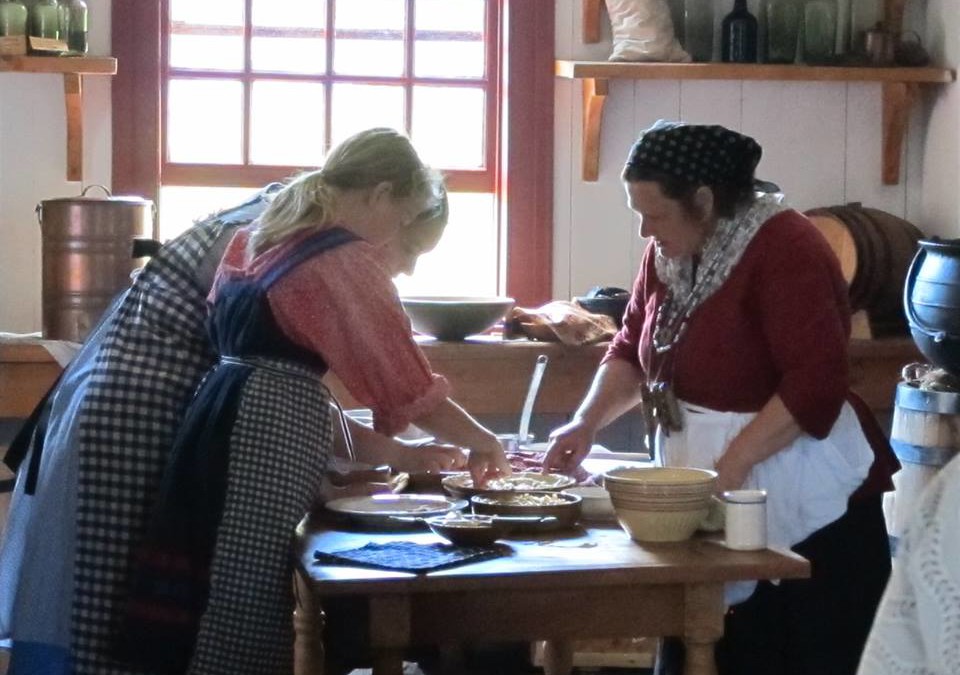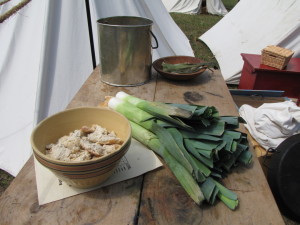For more than 20 years, La Compagnie has cooked in the great kitchen at Grand Portage during the annual rendezvous and pow-wow days. For much of that time, members and friends prepared a grand meal for all participants . . . turkeys were roasted, great vats of pickles made, gallons of wild rice prepared and dozens of pies baked.
But when the guest list approached 300, and the wear and tear on site equipment, staff and volunteers became apparent, we switched gears and instead provided a grand regalé of sweets and desserts.
After a few more years and the loss of two of the greatest rendezvous cooks —Diana Bergstrom and Mary Vanderpoel— we again switched gears. We still provide a grand regalé during the Saturday night dance, but our focus is now on a more historic offering of refreshments. We still cook up a storm in the kitchen, but now our focus is on cooking fancier dishes, from historic recipes, as a grand, on-going demonstration of what the partners of the North West Company ate at their rendezvous.
This blog about provisions is part one of a series on what we cook, and why.
The annual rendezvous at Grand Portage was the culmination of the year’s trade by some of the most successful businessmen of the 18th century. The partners of the North West Company, as befitting their business success and social status, no doubt expected to celebrate in grand style.
Each day, lavish multicourse meals were served prior to the business meetings. In the evenings, there was music, dancing, games and refreshments.
North West Company partner Alexander Mackenzie described the accommodations at the annual rendezvous . . .
The mode of living at the Grand Portage is as follows: The proprietors, clerks, guides, and interpreters, mess together, to the number of sometimes an hundred, at several tables, in one large hall, the provisions consisting of bread, salt pork, beef, hams, fish and venison, butter, peas, Indian corn, potatoes, tea, spirits, wine, & c. and plenty of milk, for which purpose several milch cows are constantly kept.
These Nor’westers conducted business on a global scale. Understandably, the procurement of their food supplies was no different – the opulent lifestyles of the partners become even more apparent when reviewing company inventories and traders’ journals.
Coffee was imported from North Africa, tea came from China, while cocoa was shipped from Central and South America. Refined white sugar made its way from the West Indies, lime juice from South America, olive oil from Greece, cheeses from England, spices from Asia and the Middle East, and wines from France and Spain. Butter and flour for baking bread and biscuits came from Detroit and Michilimackinac.
Company account books further detail the profusion of foodstuffs provided for the partners and their staff. Veal chops, roasts of mutton, and sausages. Exotic imported fruits, including figs, prunes, raisins, lemons, and limes. A variety of condiments such as vinegar, dried lemon peel, and bottled mustard.
While most provisions for the partners’ rendezvous meals were imported, archeological research yields evidence of local food sources as well.
The faunal remains show that domestic animals—beef, sheep, perhaps goats, pigs, and chickens—were raised at Grand Portage and later butchered for food. Many local species of wild game also appear in the archaeological record, confirming that deer, elk, beaver, muskrat and rabbit, wild turkey, catfish, and drumfish were hunted and eaten as well.
Large amounts of food, such as corn, maple sugar, wild rice, blackberries, cranberries and hazelnuts, were also procured locally from the Ojibwe.
And there was a garden at Grand Portage, although Mackenzie declared that “nothing but potatoes have been found to answer the trouble of cultivation.”
Still, diaries of traders at interior posts beyond Grant Portage and a 1797 inventory suggest that other vegetables such as turnips, carrots, beets, cucumbers, melons, squashes, and cabbage were grown as well.
Whether locally grown, raised or hunted, traded from the Ojibwe or imported from sources around the world, the provisions for the annual rendezvous at Grand Portage were considerable. Imagine how extensive and elaborate the menus!
Coming soon: Cooking for the Gentlemen, Part II . . . how we use primary sources to figure out what to cook based on the provisions available.



